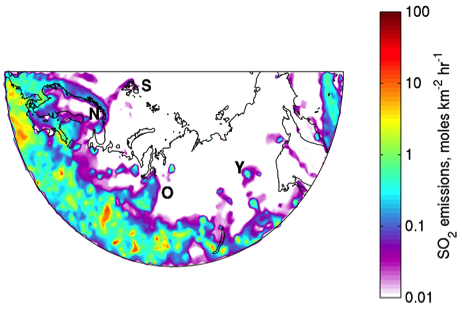Background:
The Arctic, often perceived as pristine by the general public, is actually a receptor for pollution transported from distant source regions at mid-latitudes via atmospheric and oceanic pathways. In addition to remote sources, the Arctic is also under the influence of emerging local emissions, located within the Arctic or sub-Arctic. Whilst present-day Arctic pollution predominantly originates from mid-latitude human activities (combustion, energy production, transport, agricultural fires), local pollution sources already provide significant inputs in some areas with new anthropogenic sources recently identified, but still poorly quantified (e.g. metal smelting, oil/gas flaring, wood burning). Close to anthropogenic emission sources high levels of pollutants (e.g. aerosols, ozone) may degrade local air quality, increasing the risks of respiratory/cardiovascular diseases and cancer. Many of the pollutants found in the Arctic are known to be toxic to marine and terrestrial ecosystems and humans. For instance, persistent organic pollutants (POPs) and mercury (Hg), particularly long-lasting in cold environments, enter food webs and tend to bio-accumulate, notably in Arctic fauna at the top of the food chains (e.g. marine mammals, seabirds) and in humans with potential effects on endocrine, immune and reproductive systems. Deposition of pollutants, for example acidic compounds (sulphur, nitrogen) or mercury, can also affect ecosystems and marine biogeochemical cycles or entry of bioavailable mercury into food-webs. Some air pollutants, the so-called short-lived climate pollutants (SLCPs), also play an important role in Arctic climate. Whilst carbon dioxide is the major driver of global climate change including Arctic warming, other trace gases, notably methane and tropospheric ozone, and aerosols (e.g. black carbon/BC) also make significant contributions to the Arctic radiative balance. Aerosols may also influence Arctic climate through their effects on cloud formation and evolution (the aerosol indirect effect) but these effects are poorly characterized in the Arctic.
Work Plan:
To address project objectives PARCS is designed around 5 inter-linked work packages focusing on anthropogenic pollutants and their impacts on human society (WP1), feedbacks with natural cycles (WP2), impacts on marine ecosystems (WP3) and climate (WP4) and an overarching WP5 on project synthesis and coordination. In PARCS, new data will be collected from 2015 to 2017. We focus on three study regions to address key uncertainties and making use of existing national/international expertise and research infrastructures:
 |
Anthropogenic SO2 emissions (from EU-ECLIPSE, Winther et al. 2014 (shipping)) + PARCS study regions |
- Norwegian coastal region (N on map) already experiencing local pollution (shipping, oil/gas extraction, wood combustion, downwind from Kola metal smelting (N. Russia) -> for the first time novel Ultra-Light Aircraft (ULAs) and ground-based observations will be deployed to characterize pollutant spatial distributions along the coast and study aerosol-cloud interactions and their impacts on climate which remain poorly quantified and characterised in models.
- Siberia contrasting the Ob Valley region (north-west Siberia) (O on map) which is highly industrialized due to oil/gas exploration and related development with the region south of Yakutsk (Y on map) (eastern Siberia), less industrial, but with long history of resource extraction, combustion -> characterization of pollutant sources; consultation with local communities to understand pollutant perceptions and risks; community-based pilot study on local air quality; mercury cycle observations in Ob, Lena and Yenisei rivers.
- Svalbard and surrounding seas (Arctic Ocean) (S on map) provides a contrast to the 2 other regions since, apart from summer cruise/fishing shipping, it is primarily influenced by long-range transport of pollution from mid-latitudes -> deployment of new instrumentation (Svalbard) to quantify pollutant deposition and aerosol-cloud interactions; mesocosm experiments to study the impacts of pollutant deposition on emissions to/from the ocean; sampling and analysis of pollutant levels in sea-birds making an important contribution to a recently established pan-Arctic network; observations of marine mercury cycle across the Arctic Ocean.
In addition to new data collection and analysis, existing data (ground-based, satellite) will be used to improve process-level understanding and treatments in models. Modeling approaches vary from the use of 1D models to examine cloud-aerosol processes or boundary-layer chemical processes to 3D regional models used to analyze and evaluate impacts related to anthropogenic pollution and natural sources and a coupled ocean-biogeochemical model to investigate the response of oceanic biogeochemistry to changes in nutrient inputs (from pollution sources) and Hg inputs.